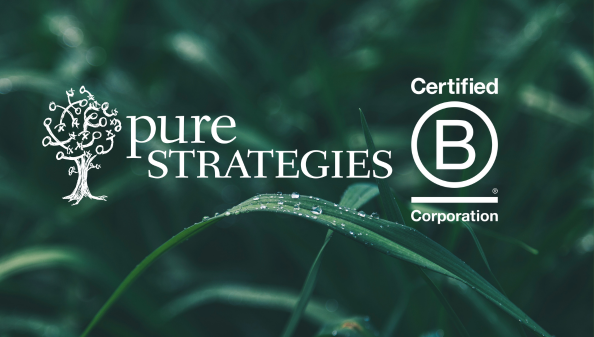This article was co-written by Colleen Corrigan.
While the climate crisis has the attention of many businesses around the world, there’s less awareness about the private sector’s relationship to nature. A recent study found that over half the global gross domestic product, worth $44 trillion dollars, is at risk due to the loss of nature.
Further, a key strategy for addressing climate change is the protection of nature and its diversity. Unfortunately, natural ecosystems that are the most effective at storing carbon are also the most at risk of being lost due to unsustainable practices.
These facts alone should spur businesses to look closely at the connection their business has to biodiversity and how to preserve it. Although biodiversity protection is a nascent topic for corporate action, we may be at a turning point, especially as the world’s governments continue to deliberate policies.
National leaders from across the globe are currently negotiating a set of goals and targets, called the Global Biodiversity Framework, that will guide sustainable use and environmental protection commitments, management and governance decisions for the next decade. One of the Framework’s key proposed targets aims to protect one-third of the Earth’s lands and seas. The Science Based Targets Network (SBTN) is translating how companies can contribute to these aims and meet planetary boundaries through its Science-Based Targets for Nature Initial Guidance for Business. Companies are now piloting this data-driven approach to develop targets that aim to protect and restore nature.
Assess business impacts on nature
To begin taking action to protect biodiversity, similar to climate goals, companies need to start by understanding their impact, hotspots and improvement opportunities for biodiversity. The SBTN initial guidance points to first leveraging industry-level assessments and existing company assessments to see what nature topics emerge. This is followed by deeper exploration which may leverage a lifecycle assessment, water risk assessment, and additional issues such as:
- Conversion: Land use and degradation, deforestation risk
- Exploitation: Water use and risk, mining
- Pollution: Chemicals, sediment, plastic
- Disturbances: Invasive species, habitat risks
A unique aspect of biodiversity and nature assessments, as compared to climate assessments, is that they include consideration of the actual geographies that are impacted and the health and quality of nature at the location of the company’s activities. For example, the large-scale Topaz solar farm is located in California’s Floristic Province, a biodiversity hotspot with unique species and ecosystems. Because of this special environmental location, the company has developed pre- and post-construction monitoring of the grassland habitat to ensure that their solar energy production and land use is responsible and that it also helps enhance biodiversity and protection of native wildlife at the site.
During the assessment phase, it’s important to look at a range of issues across the value chain including operational, upstream and downstream activities. This involves a review of the biodiversity that is impacted by the extraction or production of the materials used in the business. For example, L’Oréal, a corporate member of SBTN, sources around 1,600 raw materials for their products from nearly 350 plant species; while most of their plant-based ingredients are already sustainably-sourced, their assessment of these raw materials led to their aim to reach 100 percent sustainable sourcing by 2030 and limit their land occupancy to 2019 levels as a means to protect biodiversity.
Define the approach
Following the assessment phase, businesses can use the understanding of impacts, hotspots, and improvement opportunities to define which priorities to address and then set goals. Applying common best practices when developing goals (e.g., SMART criteria: Specific, Measurable, Attainable, Relevant, and Time-Bound; engaging stakeholder input, and so on) can ensure that biodiversity goals are easier to track and achieve. At this stage where metrics are being defined, a better baseline than was used for the assessment phase may need to be established to inform the goals and outline a clear plan.
Some companies provide useful examples for goal-setting, such as L’Oréal, which has agreed on three goals for biodiversity, the first noted above plus limiting impact on natural habitats and by 2030, 100 percent of industrial sites and all operated buildings will have a positive impact on biodiversity, compared to 2019.
Similarly, Kering has defined their approach to achieve net positive impact on biodiversity by 2025 by developing measurable biodiversity goals. These timebound goals include spatial metrics: Regenerating and protecting an area around six times the total land footprint of Kering’s entire supply chain, all the way back to raw material production; convert 1 million hectares of farms and rangelands in its supply chain landscapes into regenerative agriculture; and protect an additional 1 million hectares of critical, ‘irreplaceable’ habitat outside of its supply chain through programs that support biodiversity protection, carbon sequestration, and livelihood improvements.
Activate biodiversity protection
Finally, making effective progress requires the integration of biodiversity factors into core business practices as well as collaborating externally. These include establishing policies, developing guidance and tracking progress.
In executing its commitment to regenerative agriculture, Danone established regenerative pillars with specific expectations defined to engage its suppliers and survey their actions. PepsiCo has a similar approach through its Sustainable Farming Program to spread regenerative farming practices across 7 million acres, approximately equal to its entire agricultural footprint. The company reviewed progress across the full supply chain in over 60 countries and engaged with stakeholders to make an impact.
To implement their biodiversity goals, some companies are finding strength in collaboration, joining efforts such as members of the Fashion Pact where over 60 organizations from the fashion and textile industry have committed to restoring biodiversity as a part of their business operations. Another example includes the Forest Positive Coalition of the Consumer Goods Forum, which works with companies whose collective ambition to remove commodity-driven deforestation from supply chains is guided by agreed measures that are reported and tracked. There is also the CEO-led One Planet Business for Biodiversity (OP2B) effort which has a specific focus on regenerative agriculture and advocacy opportunities through the Business for Nature coalition.
In addition to learning from the businesses and examples noted above, the Pure Strategies free self-assessment tool on science-based targets for nature can help companies identify areas they can leverage for protecting and restoring biodiversity and how to take next steps.
This isn’t just a critical time for the planet and humanity, but also an encouraging time. We are at the beginning of the pivotal point where companies are understanding the importance of nature to their business and starting to take meaningful action. No matter where your company is on that journey, there are opportunities and benefits for advancing sustainable strategies that include your business and biodiversity.
This article originally appeared in GreenBiz on August 3, 2021.


